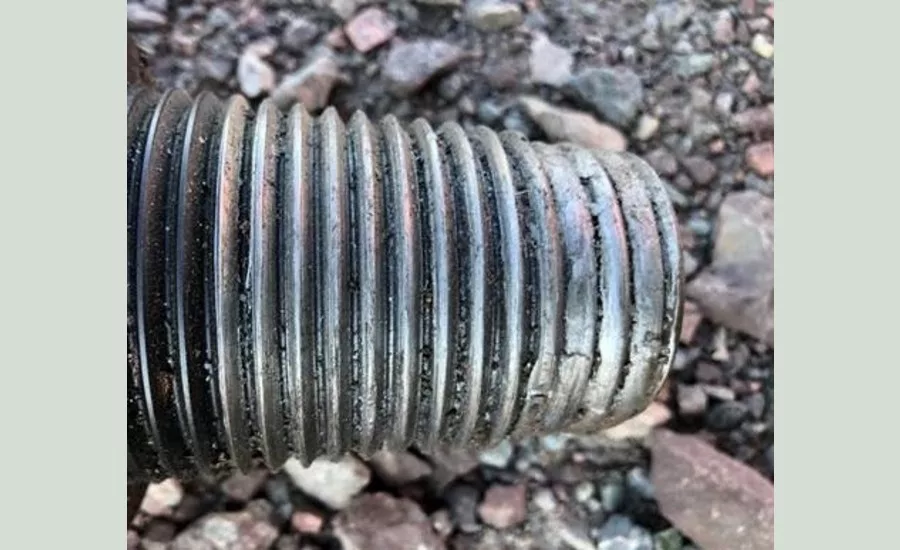Troubleshooting Drill Pipe: What You Don’t Know
On Drilling Jobsite, Solutions Only as Broad as Your Expertise

Many factors can cause premature thread wear, but you can more likely solve the issue if you know all the questions to ask.
Source: David King
Sometimes we just don’t know.
In the early 1980s, we received a complaint of thread problems from an Oklahoma customer. After a month or two of drilling, the threads had become damaged and unusable. The customer ran 2⅞” flush joint drill pipe a Schramm T64. They hoped to strike oil at around 1,100 feet.
We asked for a sample and examined it, only to find no definitive causes of the problem. Since our customer was one of our best OEM accounts, we offered to replace the drill pipe. We took extra care in manufacturing the replacements — especially double-checking our threads. We sent out the replacements only to get a call a few weeks later that it was happening again. We planned a trip to visit the rig.
Typically, a manufacturer’s thread issue appears very quickly, perhaps in the first couple of holes. However, given I had no experience running a drill rig, I had limits to my technical experience and troubleshooting. I hired a former Schramm start-up man named Jones (I cannot recall his first name). Jones had been all around the globe starting up new Schramm rigs, including a stint in Africa where he slept in an empty 55-gallon drum for two weeks.
One concern I had centered on the drill pipe having a 2⅜” FEDP (Failing Exploration Drill Pipe) connection to the 2⅞” OD flush joint. I thought this a poor choice of connections. The 2⅜” FEDP had an oversized thread for this diameter of drill pipe. You may hear people describe the imbalanced connection as “box weak” or “pin strong.” In this case, I brushed aside the concern because we had an OEM print. Certainly, the OEM’s engineers verified that this combination was OK.
I met Jones in Oklahoma City and headed out to the rig in southern Kansas the next morning. Once there, I observed the crew adding new drill pipe. I could see aspects like alignment, ease of make-up and care taken. Jones watched the operator, to see if he did anything that might contribute to the issue. Every so often, we inspected the connections.
Before I left for this trip, I checked the weather and thought I had packed well. But, I had under estimated that Kansas wind and it was downright cold. While waiting for drill rod changes, I spent a lot of time near the rig’s exhaust, trading inhaled diesel emissions for heat. That night on the way back to the hotel, we stopped so I could buy warmer clothes.
On site the next day, my heart sank as I observed the beginnings of thread damage on some connections. Jones saw nothing abnormal in the operation of the rig. Now what? I do not know who was more disappointed with the dry hole: me or the property owner.
What were my options?
Try another replacement string? We tried everything with the replacement string we sent, so we could probably expect similar results with any replacement string.
Tell the driller that the problem is not ours. We took extra care and conducted thorough inspections on the replacement pipe, so the problem must lie elsewhere. Remember, however, that the sale went through a good OEM customer. Taking this route would transfer the problem to the OEM, potentially damaging our relationship with that company.
I opted to bite the bullet. We would refund the money and take back our drill pipe. Although the OEM was not exactly pleased, they understood the situation. Since we could not solve the problem, they could work with another source.
While this did take us out of the picture, I hoped it would resolve the problem for the contractor. Of course, I can’t deny wondering, in back of my mind, if the new supplier would face the same problems we did.
I still think about this. Applying today’s experience, was our information on the 2⅜” FEDP connection correct? We did not have an official print, which meant we reversed engineered the connection. Did we have a hardened ground thread gage, or did we use a “size piece”?
Was the problem a torque issue relating to the fact that the 2⅜” FEDP was an oversized connection for the 2⅞” OD tool joint? Being somewhat naive at that time, I never considered it. Now I would try to determine if that damage was due to under or over torquing. I should have gone to a thread consultant for their opinion. Maybe then, the problem could have been resolved and I could have learned something new.
To check out more of our columns, click here!
Sometimes the problem lies in not knowing what we do not know. I did not know about make-up torque and balancing connections, so I did not consider them issues. Without that knowledge, these aspects went uninvestigated. I should have sought expert advice.
Looking for a reprint of this article?
From high-res PDFs to custom plaques, order your copy today!





